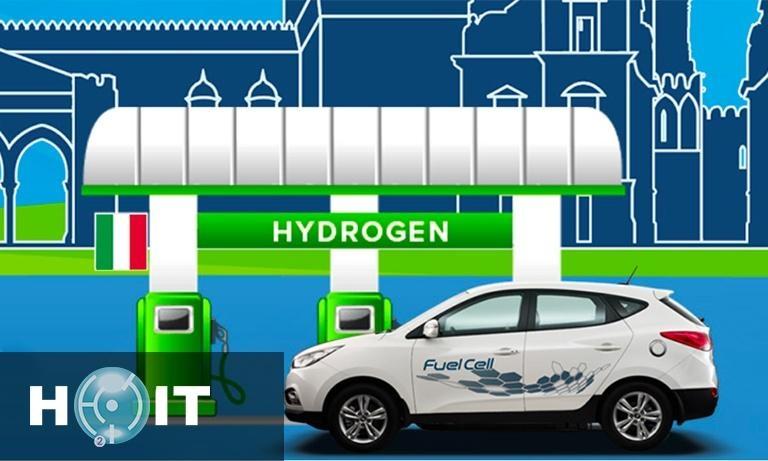
Priorities for the development of a hydrogen value chain in Italy
by Luigi Crema
DOI 10.12910/EAI2021-013
In November 2020, H2IT, the Italian Hydrogen Association, released the report “Support tools for the hydrogen sector. Priorities for the development of the hydrogen supply chain in Italy". Born from the collaboration between 48 industry players, 12 research centers and 7 clusters and associations, the report contains the essential recommendations for creating the political and regulatory conditions to support the hydrogen sector in Italy. There are 51 priority actions and 66 policies indicated to the political institutions, divided into 7 different segments: production, transport, distribution and treatment, storage, mobility, energy uses; industrial, residential and feedstock uses, supply chain and transversal issues.
Nel novembre 2020 H2IT, l’Associazione Italiana Idrogeno ha diffuso il report: “Strumenti di supporto al settore dell’idrogeno. Priorità per lo sviluppo di una filiera dell’idrogeno in Italia”. Frutto della collaborazione fra 48 imprese, 12 centri di ricerca e sette fra cluster e associazioni, il report indica le raccomandazioni essenziali per creare le condizioni politiche e regolatorie per supportare lo sviluppo di questo settore nel nostro Paese. Il report individua 51 azioni prioritarie e indica 66 azioni di policy alle istituzioni politiche, suddivise in sette diversi segmenti: produzione, trasporto, distribuzione e trattamento, stoccaggio, mobilità, usi energetici, industriali, residenziali e come materia prima.

Luigi Crema
Vicepresident H2It, Director Center on Sustainable Energy – Fondazione Bruno Kessler
Hydrogen has entered the political agenda of several countries at the international scale, including most of the EU Member States, and the European Commission itself, with the release of the European Hydrogen Strategy on last July 8th, 2020. All the strategies are looking to reserve relevant investments to the sector. The European Commission last July laid out its vision to promote green hydrogen up to 2050, which is expected to lure up to 470 billion euros in investments.
The future of the hydrogen supply chain in Europe in 2050 could reach a quarter of the share in final energy consumption, with a turnover of 820 billion euros a year, capable of creating approximately 5.4 million new jobs. A real revolution that in less than thirty years could change the society and economy of the Old Continent: if produced from renewable sources, through the process of electrolysis of water, hydrogen is free of both carbon and polluting emissions. A key solution to favor the decarbonization of the energy system and achieve climate goals.
Indeed, several barriers are still present to reach an economic viability of green hydrogen and open the hydrogen sector in all its potential. There is a need for a certain and simplified legislative framework and a long-term investment plan to develop infrastructure and finance research and innovation.
H2IT Report on barriers and priorites in the hydrogen sector
For this motivation, in late 2019, H2IT, the Italian Hydrogen Association, started up a joint work for the analysis of the barriers and identification of the priorities in the hydrogen sector in Italy. After a year, in November 2020 we released the report “Support tools for the hydrogen sector. Priorities for the development of the hydrogen supply chain in Italy".
We started from the analysis of the hydrogen sector as it is today. Hydrogen currently represents a modest fraction of the global and European energy mix. In our country, the total share of energy produced by hydrogen is around 1%, used by chemical, steel, and refining industries. However, it is still not clean hydrogen, but mostly produced from fossil fuels, with a release between 70 and 100 million tons of CO2 each year across the EU. On the other hand, on the decarbonization targets, hydrogen is essential to achieve the goal of reducing emissions by 100% envisaged by 2050, made even more challenging by the potential new limit of 60% reduction by 2030. The path traced by the European Commission has set two main objectives: to reach by 2024 the capacity of 6 GW of electrolyser installed to produce 1 million tons of green hydrogen, and by 2030 40 GW for a production of 10 million tons in Europe. In other words, in 2050, hydrogen could represent up to 24% of final energy consumption. Ambitious goals, like that set by the Ministry of Economic Development for Italy, which provides for a 20% hydrogen penetration in 2050.
Collaboration between 48 industry players
Hence the motivation to develop the report by H2IT. Born from the collaboration between 48 industry players, 12 research centers and 7 clusters and associations, the report contains the essential recommendations for creating the political and regulatory conditions to support the hydrogen sector in Italy. This report was drawn up with the operators of the sector under the scientific coordination of universities and research centers, within seven working groups divided by segment of the supply chain, with the participation of the Italian Gas Committee as support to the tables regarding the technical standardization. The collaboration turned out fruitful bringing the experiences of companies within a scientific methodological approach, which allowed them to rationalize, integrate and communicate them in the best way through a single scheme. The approach was initially bottom-up by collecting information and experiences and then top-down guiding the collection of specific feedback. H2IT involved also external companies so that all sectors of the supply chain were represented in a broad manner to achieve a complete vision.
The work carried out addresses the entire supply chain, comprised of:
- Production: The technologies for production each experience different criticalities. It was decided to divide the processes according to the carbon footprint, a key issue for the decarbonization objectives, and according to the distribution logic, centralized or distributed.
- Transport and distribution: Hydrogen can be transported through pipelines or through logistics with dedicated vehicles. The problems currently in transport logistics are tackled, which are essential for connecting production to end uses.
- Storage: Hydrogen can be stored at high pressures in different ways, from gaseous phase with cylinders to storage in geological units (cavities in saline deposits and, potentially, in depleted hydrocarbon deposits and deep aquifers), in the form liquid or through dedicated carriers. The storage is crucial to ensure flexibility in the production of energy from hydrogen.
Long-term strategies
- Mobility: Hydrogen vehicles represent one of the most mature technologies on the market today. The development of hydrogen mobility is linked to the distribution of refueling stations throughout the territory. Not only light mobility, but heavy road, rail and maritime vehicles offer opportunities for decarbonization of the hard to abate transport sector.
- Energy uses: Fuel cells and gas turbines, two different technologies both capable of connecting two sectors, gas and electricity, whose installation still presents regulatory gaps.
- Industrial, residential and feedstock uses: This sector segment includes the use of hydrogen for the generation of electricity and heat, in the residential and industrial sectors, and as a raw material. The issue of green hydrogen is addressed to reduce the emissions of some processes that are difficult to electrify.
- Transversal issues: Some issues remain common to the entire supply chain as they are intersectoral and therefore dealt with from an integrated perspective. We have involved the entire supply chain and leading to the elaboration of 51 priority actions and indicating 66 policies to the political institutions, divided into 7 different segments: production; transport, distribution and treatment; storage; mobility; energy uses; industrial, residential and feedstock uses; supply chain and transversal issues.
Starting from these, H2IT suggests to the institutions some strategic priorities to break down the barriers to the development of the hydrogen sector in Italy, here represented in seven main points:
- Define the long-term strategic role of hydrogen: it is essential to trace a clear direction that indicates specific actions and defined objectives to support the sector and enable investments. In the first phase of development, public support will be needed to cover existing economic gaps through dedicated and stable support in the long term.
- Develop a clear legislative and technical-regulatory framework: certain rules, simplified at the bureaucratic level and harmonized at an international level would allow companies involved in the entire supply chain to operate, on a European scenario, in favorable conditions also for investments.
- Guarantee the certification of renewable and low-emission hydrogen: a certification system based on Guarantees of Origin to promote renewable and low-emission hydrogen, in line with European directives.
A primary role for research centers
- Supporting research, innovation, and training: in this development phase, the role of research centers is primary, and they must therefore be supported with simplified accessibility funding for specific demonstration or research projects. The evolution of the sector will also require professionals specialized in a wide range of technical knowledge that can be created by investing in education, from high school to university to train future specialized technicians. An unmissable opportunity for a country that wants to restart by creating new employment opportunities.
- Develop a refueling infrastructure for mobility: the construction of a network of refueling stations for hydrogen vehicles is the best solution to allow the circulation of fuel cell vehicles for both light and heavy road transport, but also dedicated to rail transport and transport in logistics hubs, such as ports and airports.
- Encourage strategic collaboration between Hydrogen Valleys projects: it is a priority to identify the initial nuclei for the synergistic development of multiple end-uses and to develop different applications in logistics hubs (such as ports and airports) to encourage growth in demand, scale-up of devices and consequently reduce costs.
Raise awareness and inform public opinion
- Raise awareness and inform public opinion: the development of the supply chain must be accompanied by information campaigns and educational projects on hydrogen technologies and safety procedures applied.
Italy has the potential to strategically position itself in all the reference sectors of the hydrogen supply chain: production, logistics and transport, industry, mobility, residential. We have large operators and companies that are decisive in opening the market, SMEs and innovative start-ups, research centers of international importance.
With this report, created involving 67 organizations active in the sector, we wanted to give our contribution to the development of a market that will become increasingly central in the national and European economy. To overcome the challenge of decarbonization, the time has come to develop a National Hydrogen Strategy that implements a broad plan of investments and reforms. H2IT, as the only voice in the Italian panorama, is ready to work together with the institutions by providing all the necessary skills to facilitate the decision-making process.
The report is just the latest of the many goals achieved in recent years by H2IT, an association that brings together large, medium, and small businesses, research centers and universities operating throughout the hydrogen value chain. In fact, since 2016 the association has supported the competent Ministries in the elaboration of the "National Plan for Hydrogen Mobility" updated in 2019, collaborated in 2018 with the Ministry of the Interior for the drafting of the "Technical Rule” of fire prevention for the design, construction, and operation of hydrogen distribution systems for motor vehicles and the Position paper "Italian Hydrogen Strategy and Fuel Cells" was released in 2019.
H2IT - Who we are
H2IT - Italian Association of Hydrogen and Fuel Cells brings together large, medium and small businesses, research centers and universities working in the hydrogen sector. It currently has about 70 members representing the entire hydrogen value chain from production to end uses, including companies that deal with hydrogen logistics for its transport, distribution and storage, companies that develop technologies such as electrolyser and fuel cells. Companies that develop components, systems for the use of hydrogen in the mobility, residential, energy production and industry sectors. Established in 2005, H2IT has set itself the goal of stimulating the creation of infrastructure for the use of hydrogen, being a spokesperson for the players in the sector and ensuring a leadership role for Italy in the world market.

